Chicken Tractor Plans
Cut and Paste Chicken Tractor
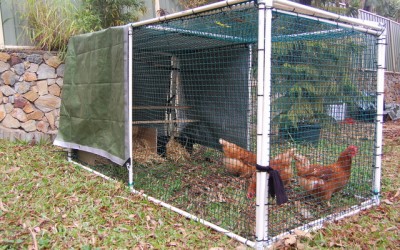
Here is a step by step guide of how to build the basic structure for a simple chicken 'tractor'.
Tractor as opposed to Chicken Coop because you can drag it around your yard for the chickens to weed, feed and toil your garden beds for you, so you don't have to do all the work. It is super lightweight to move so there is no need for wheels.
This is such an easy design you are more than capable to put it together all by yourself.
This basic design is 1 metre wide X 1 metre high X 2 metres long and best suited for 2 - 4 chickens. If you want more chickens or a larger structure you can adjust it to be as big or as small as you like! Just simply add an extension.
Contents
- Shopping List
- Important Notes
- 10 Steps to Build a Chicken Tractor
- Buying and Feeding Chickens
All items were bought from Bunnings Hardware store. Please read the list carefully BEFORE you go shopping. There may be items you want to change or you may want to shop around to get a better price.
For example, some plumbing supply shops can supply the PVC plastic joins for around $40 cheaper.
It's up to you. To make it easier we have created this list from Bunnings so you can easily shop from left to right of the store, leaving the garden trellis mesh until last. It's the biggest item to carry to the checkout on your trolley.
Shopping List
Section/ Isle
Description
Price
Quantity
These first two items are optional
Tool shop- 8
General Purpose Scissors 210 mm (F/L 6010285)
$8.97
1
Tool shop- 8
Hacksaw Box Frame (F/L 5710077)
$8.95
1
Must haves items
Tool shop-11
Disposable Mask (5823445)
$3.50
1
Cleaning-40
Rubber Gloves (9310124170420)
$2.33
1
Plumbing - 44
Cement Solvent Pressure Pipe 250ML Type P Green (9318858104179)
$8.97
1
Plumbing - 44
Press-PVC Elbow 90Deg PVE15 15mm (9319841036385)
$1.47
28
Plumbing - 44
Press-PVC Tees Plan PVT15 15mm Tee (9319841037672)
$1.99
6
Plumbing - 45
PVC Pressure Pipe Holman 15mm 1 metre class 18 PVP1518-1 (9319841030413)
$2.34
38
Indoor Timber - 48
Pine planks 90 x19x1.2 (9316504024154)
$3.12
2
Electrical- Back wall
Cable Ties Management 300 x 4.8mm Pack 100 (9337103485290)
$11.90
3
Lifestyle-20
Pegs Poly Irrigation Riser Heavy Duty Pins Pk 10 (9312261143152)
$3.10
1
Lifestyle-21
Tarpaulin Heavy Duty 2.4 x3 m (9335700590287)
$19.95
1
Lifestyle-21
Trellis Plastic Gardenmaster 1200mm X 3 Metres Green (9312620400445)
$23.44
3
Important Notes
Plastic Garden Trellis: This is NOT fox proof but is easier to use and costs less than chicken wire. If you need fox proof please use chicken wire. It is expensive to buy new so try and get some second hand from your local tip shop or free from the Freecycle group in your area.
PVC Joinery: Please make sure that when you buy the elbow joins and the tee joins that they do NOT have thread inside like a screw on. They need to be smooth inside like this one:
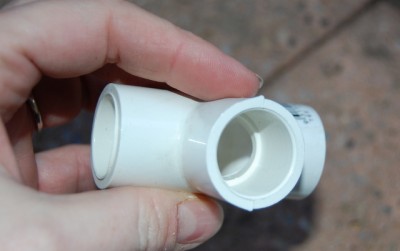
Scissors. It is important you use a sharp pair of scissors suitable for the job. Here is a pair of scissors which are most suitable for the job. These scissors are on your Bunnings shopping list.
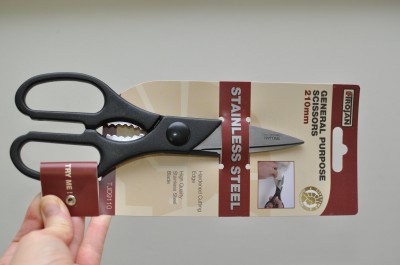
10 Steps to Build
STEP 1. Making the End Frames with Doors.
In this step you are going to make both ends of the chicken tractor including square door frames that will fit neatly inside the outer frame like this:
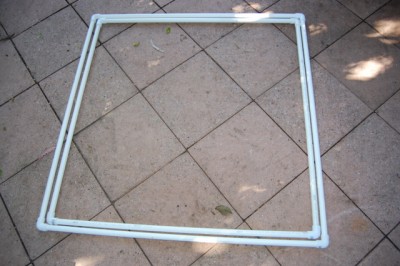
The smaller inner square will become an entry door from either end to collect eggs from one end and change water or feed at the other.
Make the smaller inner door frames first. Take 8 of the 1 metre long PVC polypipes. Measure them to be exactly 94 cms long (or mark 6 cms (60mm) off the end). The base of the PVC tee join is exactly 6 cms so you can use this as a measuring guide if you want to save some time.
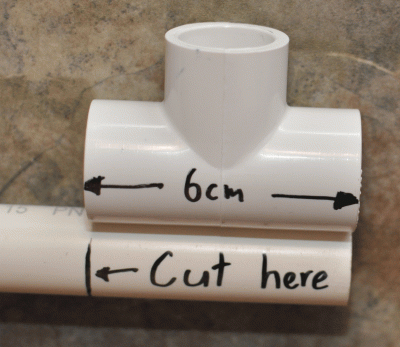
Use a hacksaw to cut each one individually. If you have never used a hack saw before here is a link to a video which shows you how to use a hacksaw. http://www.youtube.com/watch?v=wkPA3Pwjbpc
After you have cut your 8 pieces of PVC polypipe you will notice that the ends are really jagged.
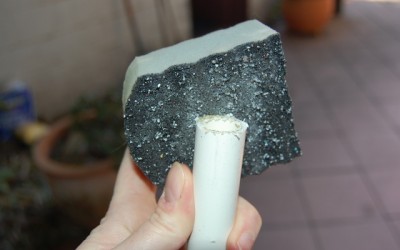
Use a piece of fine sandpaper, abrasive sponge or roll/rub the end of the pipe on concrete to smooth the burrs off.
You now have 8 pieces of PVC polypipe that are 60mm short of 1 metre or 96cm long.
Using 8 elbow joins (4 for each square) and lay out them as two squares. IMPORTANT. DO NOT TRY TO GLUE THEM TOGETHER YET or your tractor will end up looking like The Ettamogah Pub. At the moment, you are just pressing all the elbow joins and the 94 cm lengths of pipe together to form two squares. (NO GLUE!) It is a bit like putting lego together!
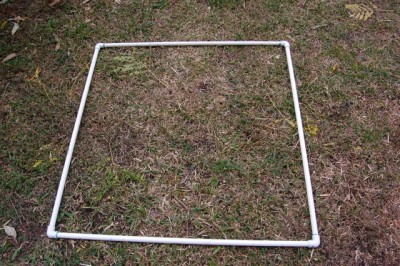
Now put this square aside, you have one more of these to make. Go for it.
Next you need to make the two larger squares that will become your door frame.
You will need 8 x 1 metre pieces of PVC polypipe and 8 elbows. Then put them all together, till you have 2 large squares. Do not glue them yet!
STEP 2. Making the Side and Top Frames
Lay out 7 x 1m PVC polypipe with 4 x elbow joins and 2 x tee joins to form this pattern.
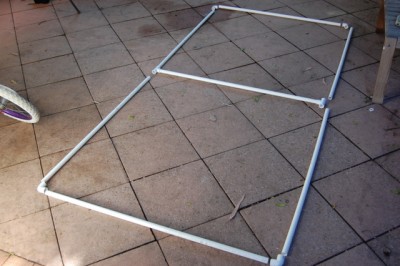
Put together another 2 frames just like this until you have 3 in total. You now have your frames for both sides and the top.
STEP 3. Glueing
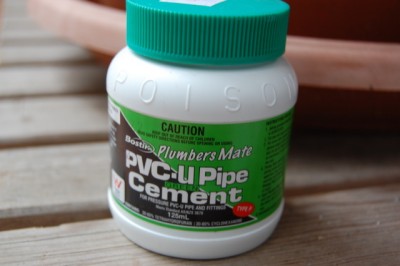
It is really important that you construct all sides of the chicken tractor before you glue them together. I repeat, assemble all the frames before you go anywhere near the glue.
The glue is smelly and messy. When the label on the glue container says you should only use it in a well ventilated area, they mean it. The stuff stinks!! Be careful. Wear gloves and work in a ventilated area. There is a brush included with the lid of the glue but I preferred to use one of the kiddies old small paintbrush.
Naomi glued her frame together outside on flat cement, Fiona used her old ugly flat fibro verandah. The glue sets within seconds and must be handled with care. Have a towel handy to wipe up spills immediately.To keep the mess contained move a piece of cardboard under each joint as you go. If you spill this glue on the floor and it sets it will not come off again.
You will need to concentrate while gluing. Do not do it with small children around. Most of the other steps can be done with little ones helping, but not this one. Industrial glue and small children should not be mixed.
This glue is very strong and sets within seconds. This means you must make sure all the assemblies are lying flat on the ground because if you glue it together and the elbow join is pointing the wrong way at the other end you are not going to get it unstuck. Keep each panel laying flat while you glue. Apply liberally and coat the inside of all joins as well as the end of the pipe before pushing the PVC polypipe into place. If you coat only one end of the pipe and not the inside of the join, or put the glue on too thinly, you risk having your structure come apart.
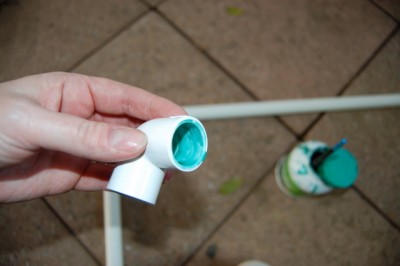
STEP 4. Attaching the Plastic Mesh
After you have glued everything together and cleaned up the mess the next step is to attach the plastic mesh to your frames. If you can, do this on your kitchen table to protect your back.
Take a side panel and lay it flat. Roll out the mesh across the panel and attach securely with cable ties. Work down one side and bottom panel first. Continue to secure with cable ties every 6 - 8 squares along the mesh.
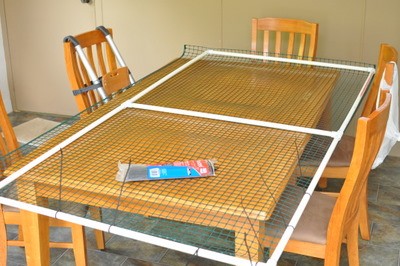
On one side you will see there is some excess mesh.
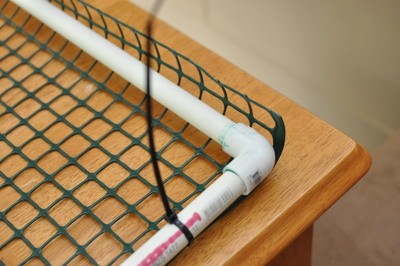
Now you need to trim off the excess with your scissors. You need to cut slightly inside the frame.
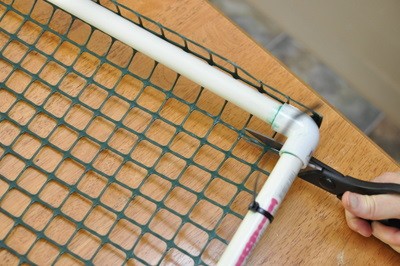 You also need to cut the mesh close to the join. Otherwise, you will end up sharp edges which will catch on things. Here is a photo of the right and wrong way to cut the mesh.
You also need to cut the mesh close to the join. Otherwise, you will end up sharp edges which will catch on things. Here is a photo of the right and wrong way to cut the mesh.
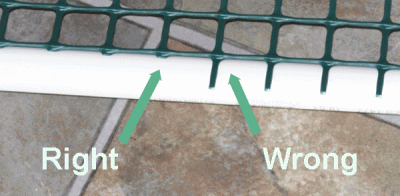
Here is a photo of what your frame will look like after you have cut the mesh and before you have attached the final sides with cable ties.
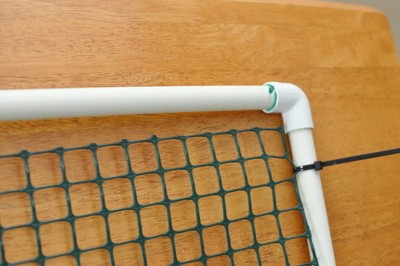
The gap between the mesh and the frame will close as you tighten the cable ties.
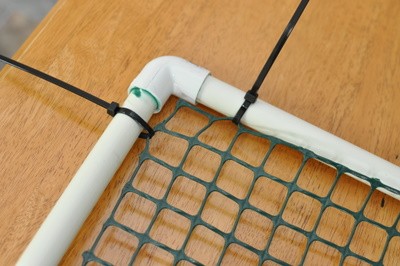
One you have cable tied the entire frame, trim off the excess bits with you scissors and then move on to the next frame. You need to do this your three largest rectangular frames and the two smaller square frames. Do not attach mesh to your two larger square frames.
You should now have:
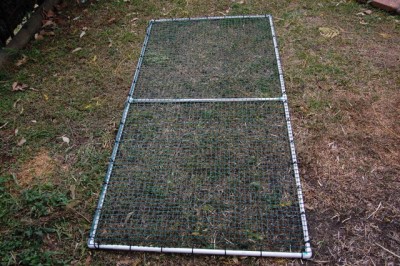
3 of these

2 of these
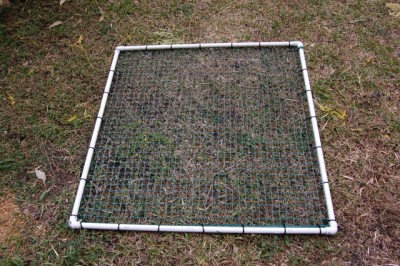
2 of these
STEP 5. Putting the Frame together
Lay one side panel flat on the ground.
Attach one large end panel (without mesh) to one end standing upgright.
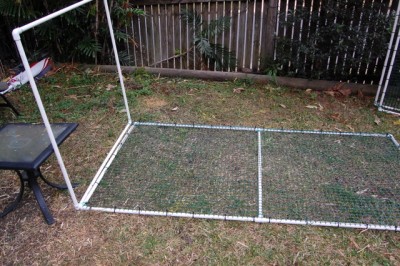
Secure with cable ties spaced approximately every 6 mesh squares along.
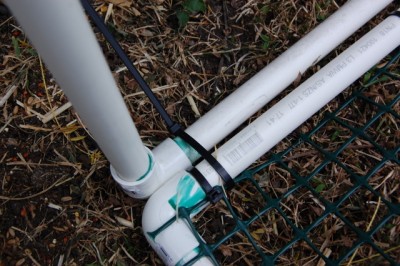
Take another side panel and attach along the bottom and also secure to the end panel.
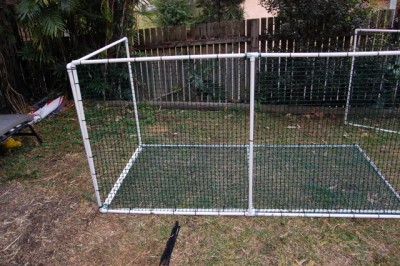
Secure with cable ties at all corners and every 6 mesh squares along.
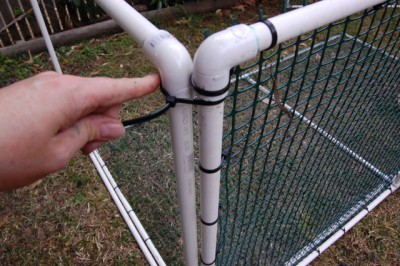
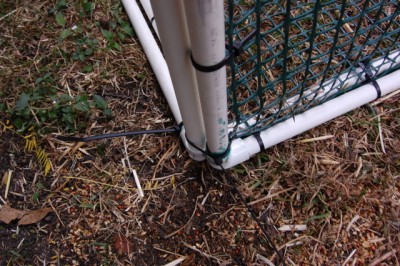
Be sure to secure with cable ties on either side of all joins.
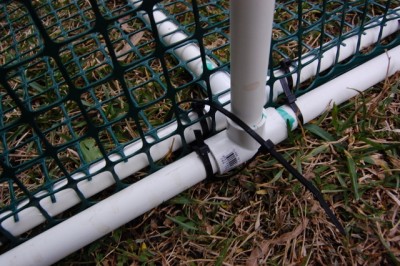
Continue to add the other end frame. As well as the other side.
Once all sides are secure roll the structure over to the right way with the roof on top.
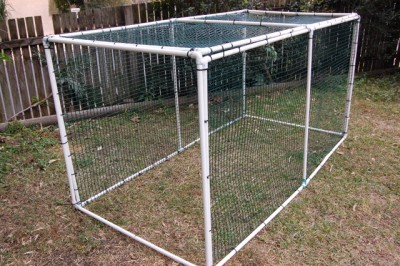
STEP 6. Putting the doors on
Remember the doors are going to fit inside the end frames like this.
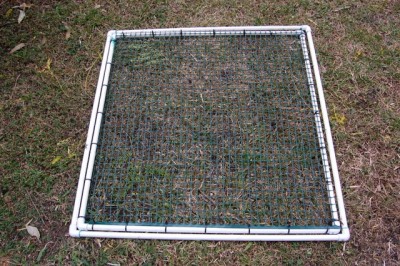
Use 7 cable ties to secure one side of the door inside the end frame.
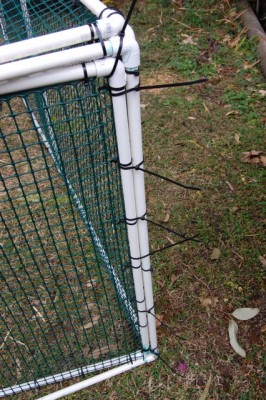
Be sure to thread a cable tie through the corner piece at the top of the door. Secure firmly.
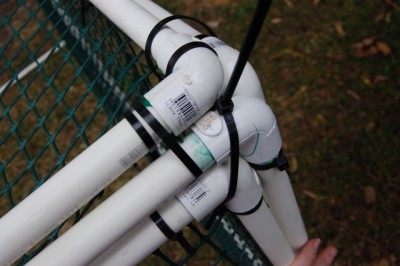
You should now be able to swing your door open and shut.
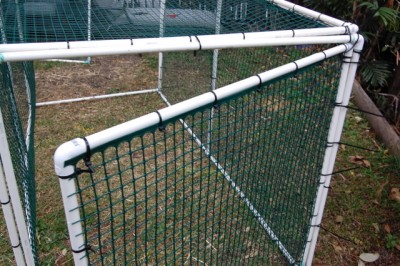
Repeat for the other end and cut off the ends of the cable ties that are still sticking out.
STEP 7. Adding a Roost
Chickens like to roost up higher at night.
Using your 1.2 metre long pine planks decide where you want your roost to go. I used 2 planks to create a step.
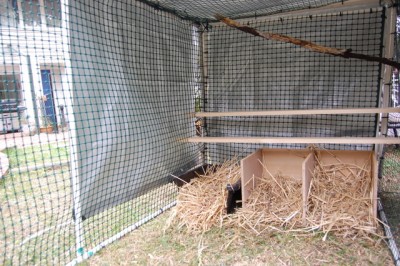
Make sure the planks are low enough for the hens to get up on yet high enough to clear your nesting boxes and allow easy access for egg collection.
Make a cut in the plastic garden mesh to secure your plank through.
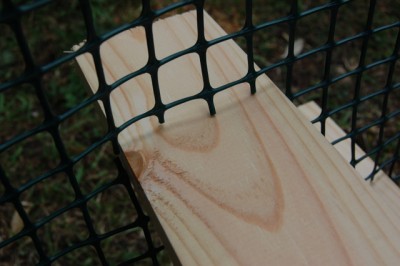
Or if you have a stick that is long enough and large enough for the chickens to roost on you can add that as well.
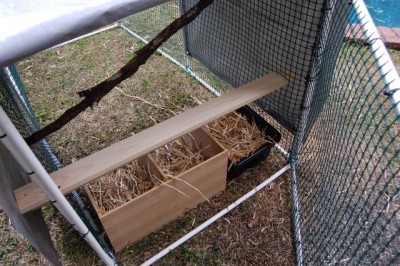
Step 8. Putting the Tarp on
Drap the tarp over half of the enclosure and secure with cable ties using the handy eyelets already manufactured in the tarp.
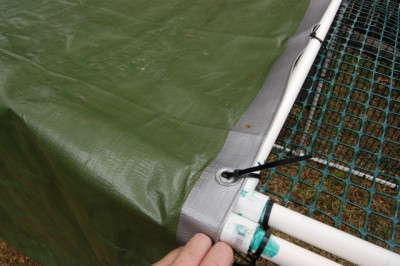
Cut the tarp so that you have no excess overhang (or not if you prefer). You can see in the picture below I've made two cuts down each side so that I am left with a neat back panel.
Secure the back flap with bricks. When you want to collect your eggs, just flip the back up and open the back door. Easy!
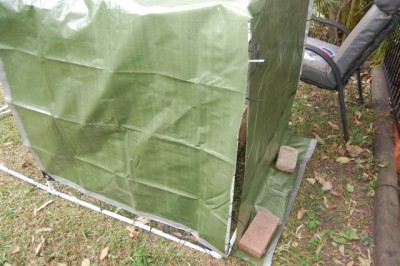
STEP 9. Nesting Boxes
The best way to save money on a nesting box is use something you already have or get creative! It does, of course have to be a suitable size for the Chicken to be able to lay in, and then they will be more than happy to use the Laying Box you provide.
You could try an old wooden crate for a nesting box, a old washing up basket (fully enclosed) which are easy to clean or basically anything that a chicken can get easy access to to lay an egg.
Here are the ideas that I am trying. The first is a two tier bookshelf I bought for $16.00 from Crazy Clarks. I built it without one side and left it open for the chickens to gain access.
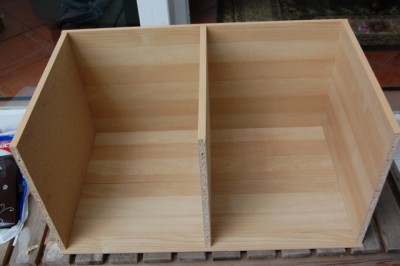
The other idea I like even better are these cheap but sturdy plastic containers. Also from Crazy Clarks they cost me $6.00 each. I used a hacksaw to make an opening. The reason why I like these is I can clean them more easily than wood.
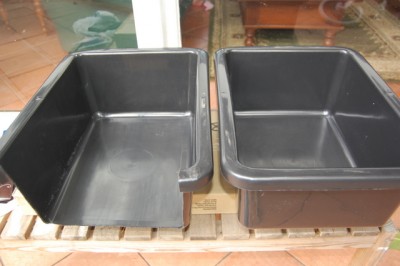
STEP 10. FINAL STEP! Securing the Tractor
This tractor is super lightweight. So you don't want it blowing around in a strong wind. Secure the tractor easily with these hook type steel pegs - a bit like pitching a tent! They can be easily removed and secured as you move your tractor around the yard.
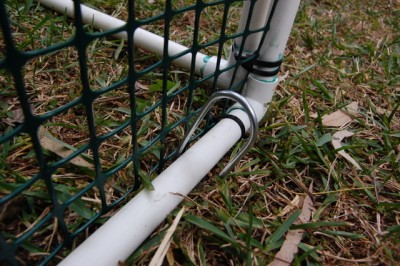
Secure the doors with old pantyhose.
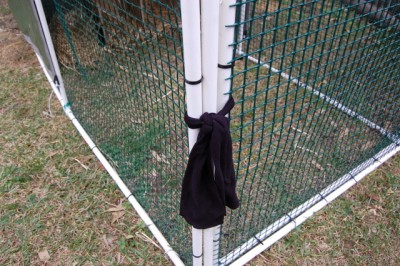
Buying and Feeding Chickens
Breeds
The easiest, friendliest, most productive type of chicken you can buy is an Isa Brown or Lowman Brown as they are sometimes called. Here is a video of Isa Brown chickens.
You can buy these chickens from a local produce store. Go to www.yellowpages.com.au in Australia and http://yellow.co.nz in New Zealand and search for a local produce store near you. Ring them first to check that they sell Point of Lay chickens.
Point of Lay chickens are already laying or ready to lay very soon. Much better than the cute, fluffy day old chicks. That way you know you won't be left with a rooster which needs to be gotten rid of.
One point of lay chicken will usually cost around $17.50 in Australia.
Feed
For point of lay chickens they are usually fed Laying Mash. It is a specially formulated chicken feed , higher in protein and various minerals including calcium suited to the nutritional needs of hens producing eggs. The mash is ground finer than normal feed and can be fed dry or moist. It also comes in pellet form.
By sure to put the feed in a sealed container or the rats will move in.
Chickens love to eat your veggie scraps from the kitchen but be a little selective. Avoid giving them meat, avocados, green peppers, onions and garlic.
Water
Chickens need to have access to water at all times. We recommend finding the largest sized metal container you can get. You don't want your chickens to ever run out of water.
Rules and Regulations
On a property less than 800m2, you are allowed to keep 6 chickens, ducks or geese without a permit. If your land is greater than 800m2, then you can keep up to 20 fowl. Your hens are able to free range but a cage is recommended for the birds' safety from predators at night.
There are different rules for different Councils. Check the regulations for keeping backyard poultry with your local Council.
The First Egg
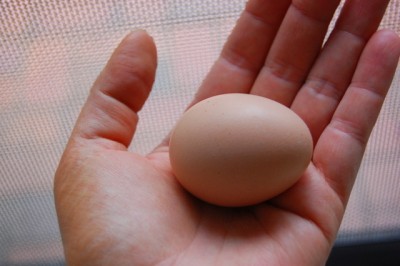
This is Naomi's first egg. She bought her chickens on a Thursday and they gave their first egg on the Friday.

